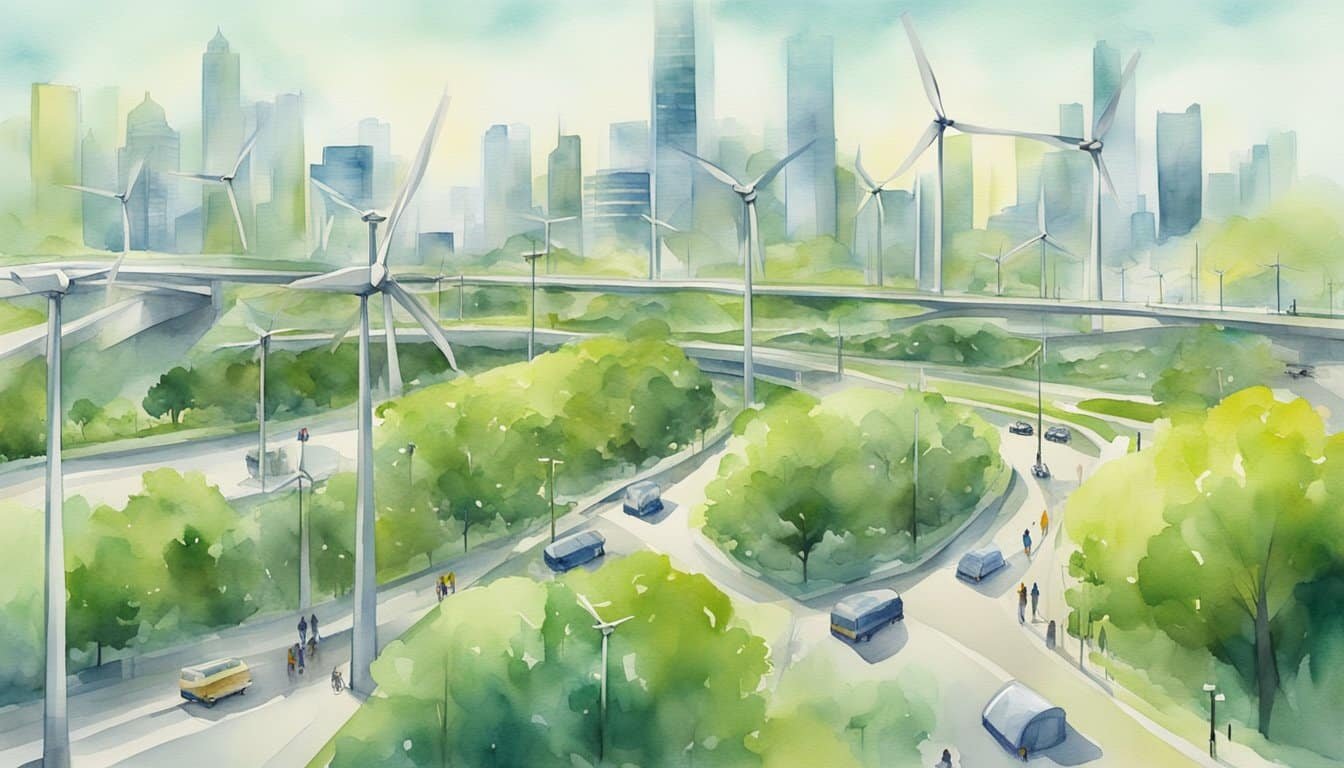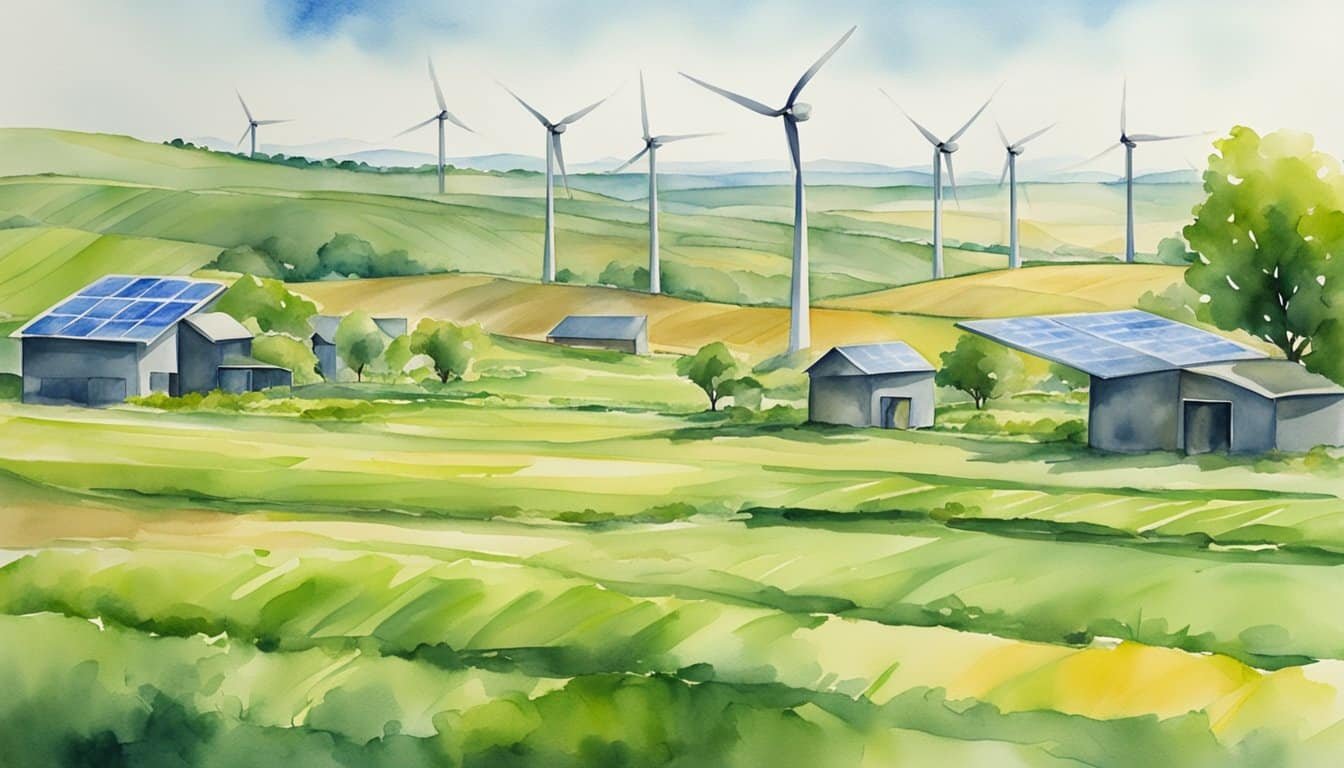Renewable Energy Adoption
In the quest to combat climate change, harnessing renewable energy stands out as a pivotal move. Accelerating the adoption of alternative energy sources not only curbs greenhouse gas emissions but also fortifies global energy security.
Wind and Solar Energy
Wind and solar energy are at the forefront of renewable adoption, providing a considerable share of global electricity. The technology behind photovoltaic cells—which convert sunlight into electricity—has advanced significantly, leading to more efficient solar panels. Similarly, wind turbines have become more effective at harnessing wind power to generate electricity. Together, wind and solar are forming the bedrock of a clean energy future. Strategically combining these resources with smart-grid technologies and battery storage systems ensures a steady and reliable energy supply, even when the sun sets or the wind calms.
- Key Wind and Solar Advancements:
- Enhanced photovoltaic cell efficiency
- Increased capacity and lifespan of battery storage solutions
- Improved wind turbine blade design for maximum energy capture
Alternative Energy Sources
Beyond wind and solar, a range of alternative energy sources are making strides in renewable adoption. These include geothermal, hydroelectric, and biomass. Each plays a critical role in diversifying the energy mix and enhancing energy efficiency. For instance, geothermal power harnesses the Earth’s heat to generate electricity, providing a consistent energy output irrespective of weather conditions. Additionally, the expansion of hydroelectric power underscores its potency in contributing to a sustainable energy landscape. Investing in research and infrastructure for these alternative sources can further solidify their position in the fight against climate change.
- Prospects of Alternative Energy:
- Geothermal energy’s low footprint and continuous output
- Hydroelectric power’s significant contribution to global renewable electricity
- Biomass potential in reducing waste and producing energy
Transportation and Infrastructure

Addressing climate change effectively requires innovation in transportation and infrastructure. Embracing clean energy solutions and enhancing public transport systems are essential steps towards sustainable living.
Clean Transportation Options
Transportation is a significant contributor to greenhouse gas emissions, but clean energy vehicles offer a breath of fresh air. Electric vehicles (EVs) are leading the charge towards a cleaner future. They’re not just good for the environment; they can be kinder on the wallet too, thanks to improved fuel efficiency. By capitalizing on renewable energy sources to power electric grids, EVs can reduce the reliance on fossil fuels.
- Driving: Swapping out traditional cars for EVs reduces carbon footprint.
- Cycling and Walking: Small changes in daily habits, like biking or walking, make a big impact.
Urban Planning and Public Transport
Thoughtful urban planning can make public transport options more appealing and convenient. Incorporating dedicated lanes for buses and bikes makes commuting safer and more efficient. Cities are reimagining their layouts, creating vibrant spaces where amenities are just a walk or a cycle away.
- Public Transport: Efficient, reliable services encourage people to leave their cars at home.
- Sustainable Transport: Integrating cycling and walking paths promotes healthier choices.
By rethinking how cities are organized, they’re not just places to live; they’re communities designed for sustainability.
Sustainable Practices in Agriculture and Consumption

Tackling climate change involves rethinking how food is produced and consumed. By focusing on reducing carbon emissions and minimizing waste, everyone can contribute to a greener planet while still enjoying tasty and nutritious food.
Agriculture Emission Reduction
Agriculture plays a significant role in climate change, as it is a major emitter of carbon and other greenhouse gases. One key strategy for emission reduction is implementing sustainable agriculture practices such as agroforestry, which integrates planting trees on farms. Trees help sequester carbon from the atmosphere, reducing the overall carbon footprint of farming operations. Furthermore, reducing meat production can make a considerable impact, as livestock farming accounts for a significant share of agricultural emissions. Switching to diets that are more plant-based can lower the demand for meat, thereby reducing associated emissions.
Carbon Sequestration Methods:
- Agroforestry
- Cover crops
- Soil management
Dietary Shifts:
- Increase plant-based food consumption
- Incorporate locally-sourced foods
Waste Minimization
When it comes to waste minimization, the focus is on reducing food waste and promoting the use of compost. Approximately one-third of all food produced globally is wasted. By improving food storage, handling, and distribution, the amount of food that ends up in landfills can be significantly decreased. When food waste is inevitable, it can be turned into compost, which enriches the soil and helps in carbon sequestration. Additionally, consumers can make a big difference by being mindful of their consumption habits, choosing sustainable options, and reducing their overall carbon footprint related to food.
Food Waste Reduction:
- Better storage and preservation methods
- Consumer education on food use
From Waste to Resource:
- Home composting programs
- Industrial compost facilities
Carbon Capture and Ecosystem Restoration

In the fight against climate change, the role of ecosystems, from our vast forests to the deep blue oceans, proves to be a game-changer. They’re not just scenic spots but superheroes in capturing carbon dioxide, a notorious greenhouse gas. This section dives into nature’s toolkit, exploring how afforestation and reforestation, alongside cutting-edge technologies, are building resilience for our environment.
Afforestation and Reforestation
Afforestation involves planting trees in areas where there were none before, transforming barren lands into green havens. It’s a powerful strategy that does more than just beautify the landscape; it actively withdraws carbon dioxide from the atmosphere. Through photosynthesis, these new green warriors turn CO2 into oxygen, making every leaf a mini-factory for cleaner air.
On the flip side, reforestation is the restoration of previously forested areas that may have fallen victim to deforestation. By planting trees in these regions, one isn’t just putting a band-aid over the scar left by deforestation; they’re effectively rebooting an entire ecosystem. Protecting existing forests and expanding them ensures that our green friends continue to act not just as carbon sinks but also as homes for countless species.
- Key benefits of afforestation and reforestation include:
- Reduction of greenhouse gas emissions
- Enhancement of biodiversity
- Protection against soil erosion
- Improvement of water cycles
Carbon Sequestration Technologies
Besides the all-natural approach, humans have gotten creative with carbon capture technologies. These are the James Bond gadgets of the environmental world — sleek, smart, and surprisingly effective. They capture carbon dioxide emissions right at the source like industrial smokestacks and store it underground or use it in other processes, stopping it right in its tracks before it can contribute to the greenhouse effect.
From Direct Air Capture devices that literally snatch CO2 out of thin air to using minerals that naturally react with carbon dioxide to form stable compounds, these methods span a fascinating range of innovations. By complementing the work done by oceans, forests, and mangroves, these technologies provide an additional defense against rising carbon levels. They show that sometimes, to tackle a high-tech problem, a high-tech solution works wonders.
- Innovative methods include:
- Bioenergy with Carbon Capture and Storage (BECCS)
- Enhanced Weathering
- Ocean Fertilization
With these approaches combined, afforestation and reforestation buttressed by human ingenuity through carbon sequestration technologies form a robust strategy. They might just give us the upper hand in ensuring a sustainable environment for generations to come.
Policy and Global Cooperation

Effective strategies to address climate change hinge on robust government climate action and international environmental agreements. Governments are key in enacting policies that curb greenhouse gas emissions, while global cooperation ensures these efforts are multiplied and standardized across borders.
Government Climate Action
Governments play a crucial role in combatting climate change through legislation and regulation. The Inflation Reduction Act, for example, represents a significant commitment by the United States to reduce carbon emissions, invest in clean energy, and offer economic incentives for sustainable practices.
They’re not alone in their endeavors. Many countries have implemented various policies aimed at reducing their carbon footprint, often informed by scientific reports from the Intergovernmental Panel on Climate Change (IPCC). Whether through carbon pricing, renewable energy targets, or funds for green technology innovation, these policies reflect a growing recognition of the risks posed by global warming and the urgent need to act.
International Environmental Agreements
International cooperation is critical in the fight against global warming, with the Paris Agreement being one of the most significant milestones. Under this accord, over 190 countries have committed to limit global temperature rise this century. World leaders convening at such forums agree on frameworks and often pledge climate finance to support environmental initiatives in developing nations.
These agreements are not just about reducing emissions; they also foster collaborative efforts in research, technology sharing, and capacity building. This spirit of cooperation highlights the consensus that no single nation can tackle environmental challenges alone – a unified response is imperative.

